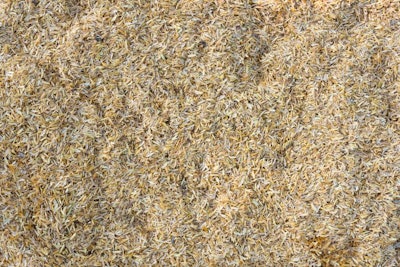
Rice producers in Kazakhstan are being urged to adopt new processing technology from South Korea to make better use of what is often seen as a waste product — rice hulls.
Rice is among the best-known agricultural products of the Kyzylorda region in south-central Kazakhstan.
Among the challenges faced by its rice farmers is what to do with the waste product when the edible grains are removed, known as rice hulls, reports Astana Times. Rice hulls contain around 20 percent lignin, a highly fibrous material that makes them unsuitable as a feedstuff, and even inhibits their decomposition in the soil.
A new solution to the “reduce-reuse-recycle” challenge with rice hulls has been found in South Korea, where a company is using new technology to break down the lignin through high-pressure compression. This process helps release the nutrients in the remaining 70 percent of the rice hull material, making an easily digested ingredient for animal feed.
Kyzylorda’s Chamber of Entrepreneurs has been so impressed by the potential of this technology as an economically and environmentally sustainable solution for the 90,000 metric tons of rice hulls produced in the region each year, that it is offering local rice producers a 50 percent subsidy of the cost of the necessary equipment.
At between US$123,000 and US$221,000, the cost of the technology represents a heavy investment by all partners, but the Chamber is hoping that farmers take up its offer and so benefit from higher future farm incomes and offset tax deductions.
Other rice products, such as stabilized rice bran, can make a useful contribution to animal nutrition. However, owing to low digestibility and a high silica content, which can cause abrasion of the gut wall and diarrhea, unprocessed rice hulls are not recommended for inclusion in feeds for monogastric animals, such as poultry and pigs.
Established uses of rice hulls in farm animal production include as bedding material for poultry and pigs, ground as a carrier for trace mineral premixes, and as an alternative source of energy for poultry house heat generation.
In 2009, researchers based in South Korea published a scientific paper reporting the successful removal of lignin from rice hulls.
According to G.Y. Wei and others in the journal, “Biotechnology and Bioprocess Engineering,” pre-treatment of the material with acid and then alkali removed at least part of the lignin and increased the yield of fermentable sugars from rice hulls. The researchers state that the hull constitutes 20 percent of the weight of a rice grain, and they considered that their process would reduce the millions of tons of rice hulls produced each year that are thrown away or used as a combustible waste.

















